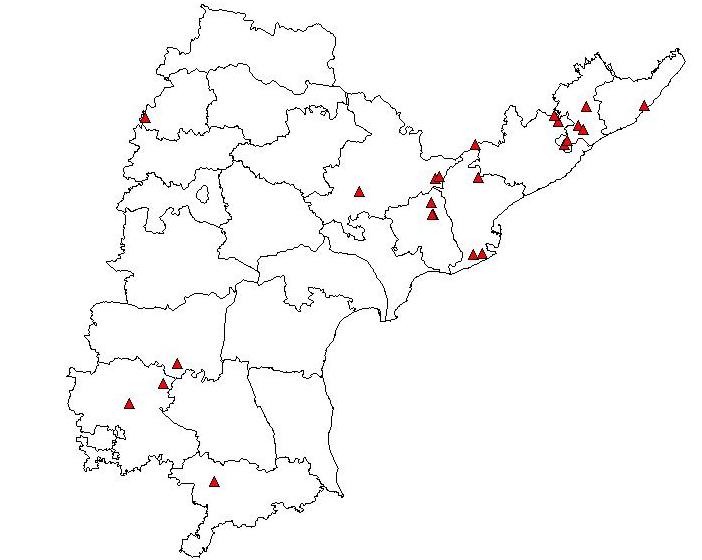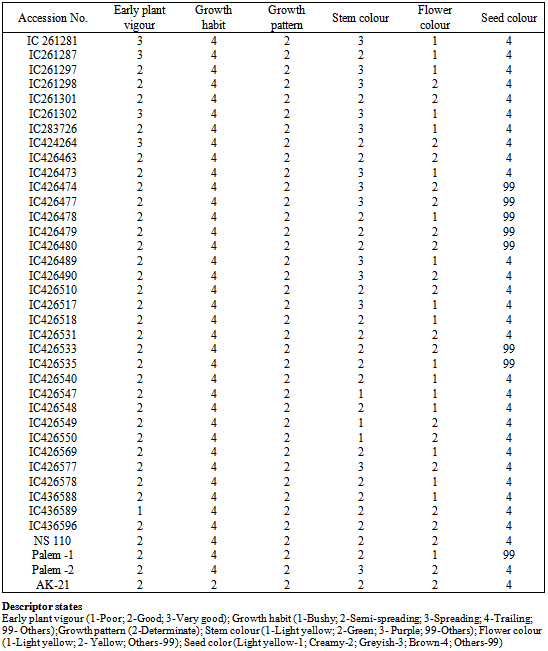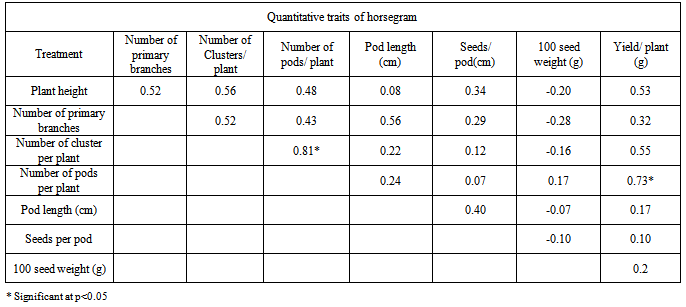Sunil Neelam1, Vinod Kumar2, Sivaraj Natarajan3, Kamala Venkateshwaran3, Someswara Rao Pandravada3
1Winter Nursery Centre, Directorate of Maize Research, Rajendranagar, 500030, Hyderabad
2International Crops Research Institute for Semi-Arid Tropics, Patancheru, Hyderabad, India
3National Bureau of Plant Genetic Resources, RS, Rajendranagar, Hyderabad, 500030, India
Correspondence to: Sunil Neelam, Winter Nursery Centre, Directorate of Maize Research, Rajendranagar, 500030, Hyderabad.
| Email: |  |
Copyright © 2012 Scientific & Academic Publishing. All Rights Reserved.
Abstract
Thirty eight horsegram accessions were characterized and evaluated during post rainy 2005-06 and 2006-07 for six qualitative and nine quantitative traits. All the accessions had trailing growth habit and determinate growth but showed variation in vigour, stem colour, flower colour and seed colour. Plant height, number of primary branches, number of clusters per plant and seeds per pod were found to be significant traits. Number of clusters per plant ranged from 22.9 (IC426518) to 95.5 (261297) and seeds per pod ranged from 4.3 (IC261287) to 6.4 (IC426478). The accessions- IC426490 (33.9 g) and IC261302 (189.1 g) produced lowest and highest yield per plant respectively. Significant correlation between number of pods per plant and yield per plant (r = 0.73) was recorded. The multivariate cluster analysis grouped the accessions into two clusters. Promising lines for number of clusters per plant viz. IC261297, IC261302 and seeds per pod viz. IC 426478 (6.4); IC 261297 (6.1); IC 261298 (6.1); IC 426569 (6.1) were identified based on analysis.
Keywords:
Germplasm,Evaluation, ANOVA, Correlation, Multivariate analysis, Agronomic traits, Macrotyloma uniflorum
Cite this paper: Sunil Neelam, Vinod Kumar, Sivaraj Natarajan, Kamala Venkateshwaran, Someswara Rao Pandravada, Evaluation and Diversity Observed in Horsegram (Macrotyloma uniflorum (Lam) Verdc.) Germplasm from Andhra Pradesh, India, International Journal of Plant Research, Vol. 4 No. 1, 2014, pp. 17-22. doi: 10.5923/j.plant.20140401.04.
1. Introduction
Legumes are important in world agriculture because they are very rich in protein and are capable of nitrogen fixation[1]. Horsegram (Macrotyloma uniflorum (Lam) Verdc.) is native to India[2] and is an important minor legume crop in the peninsular region. It has several common names including viz. madras bean, poor man’s pulse and kulat[3]. Archaeological investigations have revealed that the use of horsegram as food in India dates back to approximately 2000 BC[4]. It was identified as a potential food resource in the tropics by the[5]. Horsegram provides high quality inexpensive protein in the Indian human diet which is based on cereal or starchy food. Horsegram contains 23% protein and is richer in lysine content when compared to Pigeonpea and chickpea[6]. The fodder is protein rich and widely used as a feed to milk producing animals and horses. Horsegram, is used as a green manure which improves soil fertility tremendously[7]. The plants have high nitrogen fixation ability and helps in soil conservation[8]. Horsegram is self fertile and cleistogamous with diploid chromosome numbers of 2n = 20, 22, 24[3]. Horsegram is a short day plant; however some lines exhibit day neutral qualities as well with plants maturing in about 120 - 180 days after planting[9]. Since horsegram is a minor, low priced leguminous and drought resistant crop[10] very little scientific efforts have been devoted to horsegram improvement. Hence, the present investigation of evaluating horsegram germplasm accessions collected from diverse agro-ecological regions of Andhra Pradesh, India was conducted to identify promising accessions for utilizing them in crop improvement programmes.
2. Materials and Methods
Thirty-five germplasm lines collected from diverse agro-ecological parts of the Andhra Pradesh state in India and three control varieties viz. Palem 1, Palem 2 and AK-21 were used for the study. The experiment was laid out in an augmented block design (ABD) with seven blocks having all three checks in each block during the post rainy seasons of 2005-06 and 2006-07 at the National Bureau of Plant Genetic Resources, Regional Station, Rajendranagar, Hyderabad. The experimental plot was located at 542 m above the mean sea level. The soil is red sandy loam with a pH of 7.2. The minimum mean air temperature during the cropping season, between December to January was 14℃. The recommended agronomic practices were followed which included the application of 4 Kg N, 10 Kg P and 8 Kg of K. The horsegram seeds were sowed at a depth of 3 cm. The plots consisted of two rows of 3 m length with a spacing of 60 x 20 cm. The observations from five randomly selected plants for each accession included days to 50% flowering, plant height (cm), number of primary branches, number of pods clusters per plant, number of pods per plant, pod length (cm), seeds per pod, 100 seed weight (g), yield per plant (g) early plant vigour, growth habit, growth pattern, stem color, flower color, seed color. The data recorded for various agro-morphological traits were combined over two years and a mean was calculated. The data were analysed using the online software available at[11] for ANOVA and the SAS Enterprise guide 4.2 was used for multivariate cluster analysis. The collection sites for the genotypes were mapped using DIVA-GIS software.
3. Results and Discussion
The geographical locations for these 35 accessions from the Andhra Pradesh province in India are presented in Fig.2. The analysis of variance (table 1) has indicated significant variation (P < 0.05), for some of the quantitative traits in this study.  | Figure 2. Geographical distribution of the horsegram accessions across the state of Andhra Pradesh, India |
Table 1. Mean squares from analysis of variance for the two-year pooled data of quantitative traits in horsegram germplasm
 |
| |
|
The mean for days to 50% flowering was 63 days and accession, IC426478 was the earliest to flower (55 days) while IC261301 was late flowering (76.5 days). Among the local controls tested, AK-21 was the earliest to flower (59.4 days). Even though the mean for plant height was 97.7 cm, the maximum plant height was recorded in IC426577 (131.6 cm) and the minimum plant height occurred in accession IC426550 (65.4 cm). Among the controls, AK-21 produced the minimum plant height at 56.2 cm. The number of primary branches ranged from 4.8 (IC426547) to 8.9 (IC426569) with a mean of 6.4. Among the controls, Palem-2 produced the maximum number of primary branches (4.0). The mean for number of pod clusters per plant, was 40.9. Thirty accessions produced more than the best local check Palem-1 (28.1) with accession IC261297 producing the maximum number of clusters per plant (95.5). The number of pods per plant, varied from 81.4 (IC436589) to 458.5 (IC261297) with a mean of 188.8 and the best control variety, Palem-1, produced 169.7 pods. The maximum pod lengths were exhibited by accessions IC426540 and IC426548 (5.4 cm), whereas, the minimum pod length occurred in IC261301 (4.6 cm) with a mean of 4.9 cm and were similar to the checks, Palem-1 and Palem-2 (4.7 cm). The seeds per pod varied between 4.3 (IC261287) and 6.4 (IC426478) with a mean of 5.6. This compared favourably with the best check Palem -1 (5.4). The 100- seed weight (g) varied between 2.6 (IC426569) and 4.3 (IC261281) with a mean of 3.5 which is similar to the best check AK-21 (3.8 g). The accession, IC426490 produced the lowest yield per plant (33.9 g), however the highest yield per plant was produced by IC 261302 (189.1 g) and the mean value was of 83.1 g.Table 2. Diversity observed in some important qualitative traits in horsegram germplasm
 |
| |
|
Table 3. Correlation coefficients (r) resulting from Pearson correlation analysis of the mean quantitative traits in 38 horsegram accessions
 |
| |
|
 | Figure 1. Multivariate Cluster analysis of the horsegram germplasm lines using the Ward’s minimum variance method |
The diversity for the qualitative traits is presented in Table 2. One accession viz. IC436589 exhibited poor vigour; whereas four accessions viz. IC424264, IC261287, IC261302 and IC261281 were found to have very good vigour; remaining 33 accessions recorded good vigour. All the accessions had a trailing growth habit and determinate growth pattern. Three accessions viz. IC426547, IC426549 and IC426550 produced plants with light yellow stem colours, green colour was recorded in 22 and the remaining 13 accessions had purple stem. In flower colour eighteen accessions recorded light yellow and 20 accessions produced yellow flowers. Thirty accessions produced brown colour seeds while 8 accessions had black colour.The correlation matrix (table 3) among the traits revealed a significant correlation (p<0.05) between number of clusters per plant and number of pods per plant (r = 0.81) with the latter significantly correlated with yield per plant (r = 0.73). Multivariate cluster analysis using the Ward’s minimum variance gave two distinct clusters at semi–partial R squared value of 0.20 (Fig.1). Cluster I consisted of 31 accessions that included all the three checks, however cluster II consisted of seven accessions. Four accessions viz. IC261297, IC261298, IC261302 and IC283726 from cluster II exhibited more pods per plant and 100- seed weight. The accession, IC261297 produced the highest number of pods per plant, number of seeds per pod, and number of clusters per plant, while IC261302 produced superior numbers of pods per plant, numbers of clusters per plant, and yield per plant. The three remaining accessions including viz. IC261287 (355.9), IC261301 (304) and IC426463 (262.8) produced high numbers of pods per plant. The clustering was independent of the geographical distribution of the accessions as cluster I had accessions from all the regions of the state similar results were also reported by[12].Macrotyloma uniflorum is primarily grown as a catch crop for livestock, and human food as a pulse[3]. Variability existed in the evaluated germplasm accessions for all traits. This could be attributable to adaptability and stability of the crop under wide ranges of environmental conditions. In the present study, significant variability was observed for plant height, number of primary branches, number of clusters per plant, number of seeds per pod. Germplasm collections from this region of India have shown genetic and geographic divergence[12]. The accessions IC261297 and IC261302 were found to be superior for number of clusters per plant which significantly contributed to horsegram yield. Similar results were also reported by[13]. Although, accessions IC261302, IC261297, IC426478, IC261281, IC426549, IC283726, and IC261298 were identified as promising lines for yield per plant but only IC261297 and IC261302 recorded significant values over the check.[7],[14] and[15] also attributed more pods per plant as an important trait for high yield which was also corroborated in the present study. The accessions, IC261302 and IC261281 which had vigorous growth habit, purple stems, and light yellow flowers can be utilized as morphological markers. The absence of a correlation between number of pods per plant and 100-seed weight indicate independent assortment and irrelevance of these two traits as selection criteria for identification of superior genotypes in breeding programmes. The multivariate cluster analysis showed all three checks viz. Palem-1, Palem-2 and AK-21 as well as the low yielding accessions in cluster I. However, cluster II consisted of seven accessions which were promising for multiple yield traits including high numbers of pods per plant, similar results were reported by[6], who studied genetic diversity of 100 accessions of horsegram, D2 analysis study revealed that cluster II had the maximum mean values for numbers of pods per plant. Hence, germplasm collectors and breeders should collect genotypes which consist of a large number of pods per plant as one of the main criteria for germplasm collections and selection for promising lines utilized in developing high seed yielding varieties. The pooled analysis of two year data resulted in the identification of promising accessions and the significantly yield contributing traits viz. number of pods per plant and number of seeds per pod (table 4). This study indicates the existence of wide genetic variability among the germplasm for qualitative as well as quantitative traits. Pre-breeding efforts in horsegram genetic resources and the identification of promising genotypes form the base material will be a valuable source for utilization by breeders engaged in crop improvement programmes. Table 4. Promising accessions identified in horsegram germplasm
 |
| |
|
ACKNOWLEDGEMENTS
The authors are highly thankful to the Director, NBPGR, New Delhi and Head, PQD for the support and Officer- in-charge, NBPGR, RS, Hyderabad for the support and providing the necessary facilities for the experimentation.
References
| [1] | Shirsat, R. K., 2010, Induced mutations in horsegram: Mutagenic efficiency and effectiveness. Recent Res. Sci. Tech. 2:20-23. |
| [2] | Bogdan. A.V., 1977, Tropical pastures and fodder plants. pp. 475. Longman, London. |
| [3] | Cook, B.G., Pengelly, B.C., Brown, S.D., Donnelly, J.L., Eagles, D.A., Franco, M.A., Hanson, J., Mullen, B.F., Partridge, I.J., Peters, M. and Schultze-Kraft, R., 2005, Tropical Forages: an interactive selection tool.[CD-ROM], CSIRO, DPI&F (Qld), CIAT and ILRI, Brisbane, Australia. |
| [4] | Mehra, K. L., 2000, History of crop cultivation in pre-historic India. In: Choudhary SL, Sharma GS and Nene YL (ed.). Ancient and Medieval History of Indian Agriculture and its Relevance to Sustainable Agriculture in the 21st Century. Udaipur: Rajasthan College of Agriculture, pp. 11–16. |
| [5] | The National Academy of Sciences, 1979, In: Tropical legumes: Resources for the future, Report of an Ad-Hoc panel of the Advisory Committee on Technology. Innovation Board on Science and Technology for International Development, Washington D.C. NAS, pp.1-331. |
| [6] | Prakash, B. G., Channayya, P. Hiremath., Devarnavdgi, S.B. and Salimath, P. M., 2010, Assessment of genetic diversity among germplasm lines of horsegram (Macrotyloma uniflorum L.) at Bijapur. Electronic J. plant breeding 1:414-419. |
| [7] | Prakash, B.G., Guled, M.B. and Asha, M.B., 2008, Identification of suitable horsegram varieties for northern dry zone of Karnataka. Karnataka j. Agri. Sci. 21:343-345. |
| [8] | Yadav, S. 2004, Protein and oil rich wild horsegram. Genet. Resour. Crop Ev. 51:629-633. |
| [9] | Morris, J.B., 2008, Macrotyloma axillare and M. uniflorum: descriptor analysis, anthocyanin indexes, and potential uses. Genet. Resour. Crop Ev. 55:5-8. |
| [10] | Ramah, K. and Babu, C., 2005, Heat unit requirement for horsegram (Macrotyloma uniflorum L. cultivar as influenced by spacing and nitrogen. Madras Agric. J. 92 :392-397. |
| [11] | http://www.iasri.res.in/spadweb/index.htm. |
| [12] | Sunil, N. Sivaraj, N., Pandravada, S.R., Kamala, V., Raghuram Reddy , P. and Varaprasad, K.S., 2008, Genetic and geographical divergence in horsegram germplasm from Andhra Pradesh, India. Plant Genet. Resour. Characterization and Utilization 7:84–87. |
| [13] | Prakash, B.G. and Khanure, S., 2000, Genetic parameters, correlation and path coefficient analysis in horsegram. Karnataka j. Agri. Sci. 13:312-314. |
| [14] | Parameshwarappa, S.G, and Kumar, D.L., 2002, Performance of horsegram cultivars on medium black soils of Northern transitional zone of Karnataka. Karnataka j. Agri. Sci. 15:627-629. |
| [15] | Nagaraja, N., Nehru, S.D. and Manjunatha, A., 1999, Plant type for yield in horsegram as evidenced by path coefficient and selection indices. Karnataka J. Agric. Sci. 12:33-37. |



 Abstract
Abstract Reference
Reference Full-Text PDF
Full-Text PDF Full-text HTML
Full-text HTML


